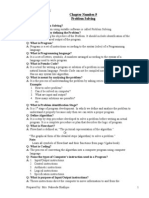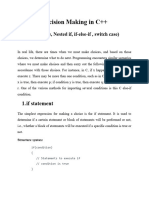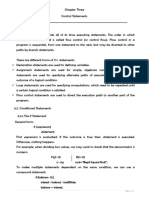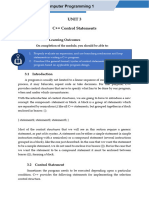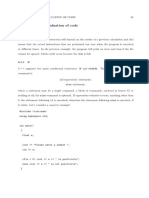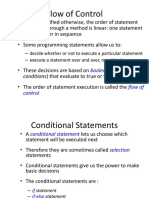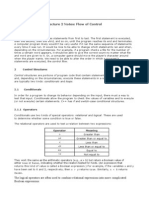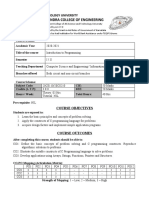Chapter 3 - Control Statements
Uploaded by
ybetre515Chapter 3 - Control Statements
Uploaded by
ybetre515Chapter Three
3. Control Statements .................... 1
3.1. INTRODUCTION ............................................................................................................... 1
3.2. CONDITIONAL STATEMENTS .......................................................................................... 1
3.2.1. The if Statement .................................................................................................... 1
3.2.2. The switch Statement ............................................................................................ 4
3.3. LOOPING STATEMENTS .................................................................................................. 6
3.3.1. The ‘for’ Statement ............................................................................................... 7
3.3.2. The ‘while’ Statement ........................................................................................... 6
3.3.3. The ‘do…while’ Statement ................................................................................... 8
3.4. OTHER STATEMENTS ...................................................................................................... 9
3.4.1. The ‘continue’ Statement ...................................................................................... 9
3.4.2. The ‘break’ Statement ......................................................................................... 11
3.4.3. The ‘goto’ Statement ........................................................................................... 12
3.4.4. The ‘return’ Statement......................................................................................... 13
3. Control Statements
3.1. Introduction
A running program spends all of its time executing statements. The order in which statements are
executed is called flow control (or control flow). This term reflect the fact that the currently
executing statement has the control of the CPU, which when completed will be handed over
(flow) to another statement. Flow control in a program is typically sequential, from one statement
to the next, but may be diverted to other paths by branch statements. Flow control is an important
consideration because it determines what is executed during a run and what is not, therefore
affecting the overall outcome of the program.
Like many other procedural languages, C++ provides different forms of statements for different
purposes. Declaration statements are used for defining variables. Assignment-like statements are
used for simple, algebraic computations. Branching statements are used for specifying alternate
paths of execution, depending on the outcome of a logical condition. Loop statements are used for
specifying computations, which need to be repeated until a certain logical condition is satisfied.
Flow control statements are used to divert the execution path to another part of the program. We
will discuss these in turn.
3.2. Conditional Statements
3.2.1. The if Statement
It is sometimes desirable to make the execution of a statement dependent upon a condition being
satisfied. The if statement provides a way of expressing this, the general form of which is:
if (expression)
statement;
First expression is evaluated. If the outcome is nonzero (true) then statement is executed.
Otherwise, nothing happens.
-1-
For example, when dividing two values, we may want to check that the denominator is nonzero:
#include<iostream.h>
int main()
{
int a=5;
int b=10;
If (a<b)
cout<<"five is less than ten";
Return 0;
}
To make multiple statements dependent on the same condition, we can use a compound statement:
if (balance > 0) {
interest = balance * creditRate;
balance += interest;
}
A variant form of the if statement allows us to specify two alternative statements: one which is
executed if a condition is satisfied and one which is executed if the condition is not satisfied. This
is called the if-else statement and has the general form:
if (expression)
statement1;
else
statement2;
First expression is evaluated. If the outcome is nonzero (true) then statement1 is executed.
Otherwise, statement2 is executed.
-2-
For example:
#include <iostream.h>
int main ()
{
int a = 100;
if( a < 20 )
{
cout << "a is less than 20;" << endl;
}
else
{
cout << "a is not less than 20;" << endl;
}
cout << "value of a is : " << a << endl;
Return 0;
}
output: a is not less than 20
value of a is :100
Given the similarity between the two alternative parts, the whole statement can be simplified to:
if (balance > 0)
interest = balance * creditRate;
else
interest = balance * debitRate;
balance += interest;
Or simplified even further using a conditional expression:
interest = balance * (balance > 0 ? creditRate : debitRate);
balance += interest;
Or just:
balance += balance * (balance > 0 ? creditRate : debitRate);
If statements may be nested by having an if statement appear inside another if statement. For
example:
if (callHour > 6) {
if (callDuration <= 5)
charge = callDuration * tarrif1;
else
charge = 5 * tarrif1 + (callDuration - 5) * tarrif2;
} else
charge = flatFee;
A frequently-used form of nested if statements involves the else part consisting of another if-else
statement.
-3-
For example:
#include<iostream.h>
int main()
{
int age, height;
cout<<"Enter your age=:"<<endl;
cin >> age;
cout<<"Enter your height=:"<<endl;
cin >> height;
if(height = = age)
{
cout << "Your height is equal to your age!";
}
else if(height < age)
{
cout << "Your height is less than your age!";
}
else if(height > age)
{
cout << "Your height is greater than your age!";
}
}
3.2.2. The switch Statement
The switch statement provides a way of choosing between a set of alternatives, based on the value
of an expression. The general form of the switch statement is:
switch (expression) {
case constant1:
statements;
...
case constantn:
statements;
default:
statements;
}
First expression (called the switch tag) is evaluated, and the outcome is compared to each of the
numeric constants (called case labels), in the order they appear, until a match is found. The
-4-
statements following the matching case are then executed. Note the plural: each case may be
followed by zero or more statements (not just one statement). Execution continues until either a
break statement is encountered or all intervening statements until the end of the switch statement
are executed. The final default case is optional and is exercised if none of the earlier cases provide a
match.
For example, #include<iostream.h>
int main()
{
switch (4)
{
case 1:
cout <<"The correct choice is one" << endl;
break;
case 2:
cout <<"The correct choice is two" << endl;
break;
case 3:
cout << "The correct choice is three" << endl;
break;
case 4:
cout << "The correct choice is four" << endl;
break;
default:
cout <<"The correct choice is five" << endl;
break;
}
}
-5-
3.3. Looping Statements
3.3.1. The ‘while’ Statement
The while statement (also called while loop) provides a way of repeating a statement while a
condition holds. It is one of the three flavors of iteration in C++. The general form of the while
statement is:
while (expression)
statement;
First expression (called the loop condition) is evaluated. If the outcome is nonzero then statement
(called the loop body) is executed and the whole process is repeated. Otherwise, the loop is
terminated.
For example, suppose we wish to calculate the sum of all numbers from 1 to some integer denoted
by 5.
#include <iostream.h>
int main ()
{
int i=1;
int sum = 0;
while (i<=5)
{
sum =sum+i;
i++;
}
cout<<"The sum=:"<<sum;
return 0;
}
For n set to 5, Table 2.9 provides a trace of the loop by listing the values of the variables involved
and the loop condition.
Table 5.1 While loop trace
Iteration i n i <= n sum += i++
First 1 5 1 1
Second 2 5 1 3
-6-
Third 3 5 1 6
Fourth 4 5 1 10
Fifth 5 5 1 15
Sixth 6 5 0
It is not unusual for a while loop to have an empty body (i.e., a null statement). The following
loop, for example, sets n to its greatest odd factor.
while (n % 2 == 0 && n /= 2)
;
Here the loop condition provides all the necessary computation, so there is no real need for a
body. The loop condition not only tests that n is even, it also divides n by two and ensures that the
loop will terminate should n be zero.
Example:
#include <iostream.h>
int main ()
{
int a = 10;
while( a < 20 )
{
cout << "value of a: " << a << endl;
a++;
}
Return 0;
}
3.3.2. The ‘for’ Statement
The for statement (also called for loop) is similar to the while statement, but has two additional
components: an expression which is evaluated only once before everything else, and an
expression which is evaluated once at the end of each iteration. The general form of the for
statement is:
for (expression1; expression2; expression3)
statement;
-7-
First expression1 is evaluated. Each time round the loop, expression2 is evaluated. If the outcome is
nonzero then statement is executed and expression3 is evaluated. Otherwise, the loop is terminated.
The general for loop is equivalent to the following while loop:
expression1;
while (expression2) {
statement;
expression3;
}
Example
#include <iostream.h>
int main ()
{
for( int a = 10; a < 20; a = a ++ )
{
cout << "value of a: " << a << endl;
}
return 0;
}
3.3.3. The ‘do…while’ Statement
The do statement (also called do loop) is similar to the while statement, except that its body is
executed first and then the loop condition is examined. The general form of the do statement is:
do
statement;
while (expression);
First statement is executed and then expression is evaluated. If the outcome of the latter is nonzero
then the whole process is repeated. Otherwise, the loop is terminated.
The do loop is less frequently used than the while loop. It is useful for situations where we need
the loop body to be executed at least once, regardless of the loop condition. For example, suppose
we wish to repeatedly read a value and print its square, and stop when the value is zero. This can
be expressed as the following loop:
-8-
#include <iostream.h>
int main ()
{
int a = 10;
do
{
cout << "value of a: " << a << endl;
a = a + 1;
}while( a < 20 );
return 0;
}
Unlike the while loop, the do loop is never used in situations where it would have a null body.
Although a do loop with a null body would be equivalent to a similar while loop, the latter is
always preferred for its superior readability.
3.4. Other Statements
3.4.1. The ‘continue’ Statement
The continue statement terminates the current iteration of a loop and instead jumps to the next
iteration. It applies to the loop immediately enclosing the continue statement. It is an error to use
the continue statement outside a loop.
In while and do loops, the next iteration commences from the loop condition. In a for loop, the
next iteration commences from the loop’s third expression. For example, a loop which repeatedly
reads in a number, processes it but ignores negative numbers, and terminates when the number is
zero, may be expressed as:
Example:
#include <iostream.h>
int main ()
{
int a = 10;
-9-
do
{
if( a == 15)
{
a = a + 1;
Continue;
}
cout << "value of a: " << a << endl;
a = a + 1;
} while( a < 20 );
Return 0;
}
Output:
Value of a:10
Value of a:11
Value of a:12
Value of a:13
Value of a:14
Value of a:15
Value of a:16
Value of a:17
Value of a:18
Value of a:19
A variant of this loop which reads in a number exactly n times (rather than until the number is
zero) may be expressed as:
for (i = 0; i < n; ++i) {
cin >> num;
if (num < 0) continue; // causes a jump to: ++i
// process num here...
}
When the continue statement appears inside nested loops, it applies to the loop immediately
enclosing it, and not to the outer loops. For example, in the following set of nested loops, the
continue applies to the for loop, and not the while loop:
while (more) {
for (i = 0; i < n; ++i) {
- 10 -
cin >> num;
if (num < 0) continue; // causes a jump to: ++i
// process num here...
}
//etc...
}
3.4.2. The ‘break’ Statement
A break statement may appear inside a loop (while, do, or for) or a switch statement. It causes a
jump out of these constructs, and hence terminates them. Like the continue statement, a break
statement only applies to the loop or switch immediately enclosing it. It is an error to use the
break statement outside a loop or a switch.
For example, suppose we wish to read in a user password, but would like to allow the user a
limited number of attempts:
Example:
#include<iostream.h>
int main()
{
for(int y=0; y<3; y++)
{
cout<<" The User is a very good programmer :"<<endl;
if(y==3)
{
cout<<" The User is a very bad programmer :"<<endl;
break;
cout<<" It was a Mistake :"<<endl;
}
}
return 0;
} output:
The User is a very good programmer :
The User is a very good programmer :
The User is a very good programmer :
Here we have assumed that there is a function called Verify which checks a password and returns
true if it is correct, and false otherwise.
Rewriting the loop without a break statement is always possible by using an additional logical
variable (verified) and adding it to the loop condition:
- 11 -
verified = 0;
for (i = 0; i < attempts && !verified; ++i) {
cout << "Please enter your password: ";
cin >> password;
verified = Verify(password));
if (!verified)
cout << "Incorrect!\n";
}
The break version is arguably simpler and therefore preferred.
3.4.3. The ‘goto’ Statement
The goto statement provides the lowest-level of jumping. It has the general form:
goto label;
where label is an identifier which marks the jump destination of goto. The label should be
followed by a colon and appear before a statement within the same function as the goto statement
itself. For example, the role of the break statement in the for loop in the previous section can be
emulated by a goto:
example:
#include<iostream.h>
int main()
{
for(int y=0; y<3; y++)
{
cout<<" The User is a very good programmer :"<<endl;
if(y==3)
{
cout<<" It was a Mistake :"<<endl;
goto a;
}
}
cout<<endl;
a:
{
cout<<" It is a result of goto statement ";
}
return 0;
}
Output: The User is a very good programmer:
The User is a very good programmer:
The User is a very good programmer:
It is a result of go to statement
Because goto provides a free and unstructured form of jumping (unlike break and continue), it can
be easily misused. Most programmers these days avoid using it altogether in favor of clear
programming. Nevertheless, goto does have some legitimate (though rare) uses.
- 12 -
3.4.4. The ‘return’ Statement
The return statement enables a function to return a value to its caller. It has the general form:
return expression;
where expression denotes the value returned by the function. The type of this value should match
the return type of the function. For a function whose return type is void, expression should be
empty:
return;
The only function we have discussed so far is main, whose return type is always int. The return
value of main is what the program returns to the operating system when it completes its execution.
Under UNIX, for example, it its conventional to return 0 from main when the program executes
without errors. Otherwise, a non-zero error code is returned. For example:
int main (void)
{
cout << "Hello World\n";
return 0;
}
When a function has a non-void return value (as in the above example), failing to return a value
will result in a compiler warning. The actual return value will be undefined in this case (i.e., it will
be whatever value which happens to be in its corresponding memory location at the time).
- 13 -
You might also like
- Beginner's Guide To AmiBroker AFL Programming88% (8)Beginner's Guide To AmiBroker AFL Programming133 pages
- Chapter 3 Contol and Desicion (Autosaved)No ratings yetChapter 3 Contol and Desicion (Autosaved)48 pages
- Steps To Be Taken For DESKI To WEBI ConversionNo ratings yetSteps To Be Taken For DESKI To WEBI Conversion23 pages
- 3 Conditional Evaluation of Code: 3.1 Flow ControlNo ratings yet3 Conditional Evaluation of Code: 3.1 Flow Control27 pages
- Repetition Structures, or Loops, Are Used When A Program Needs To Repeatedly Process One orNo ratings yetRepetition Structures, or Loops, Are Used When A Program Needs To Repeatedly Process One or15 pages
- Chapter 4 - Concurent Signal Assignments of VHDLNo ratings yetChapter 4 - Concurent Signal Assignments of VHDL79 pages
- ITEC1030_Ch04_Control Statments of ProgrammingNo ratings yetITEC1030_Ch04_Control Statments of Programming24 pages
- If Else, If Else If, While Conditions C++No ratings yetIf Else, If Else If, While Conditions C++23 pages
- Progress Basic Query Course: (Version 8.2A)No ratings yetProgress Basic Query Course: (Version 8.2A)44 pages
- Sequential Statements: Chapter Three Control StatementsNo ratings yetSequential Statements: Chapter Three Control Statements11 pages
- 2017 Chapter Three Computer Programming (ECEg 1052)No ratings yet2017 Chapter Three Computer Programming (ECEg 1052)44 pages
- Regular Student Final Exam Final ScheduleNo ratings yetRegular Student Final Exam Final Schedule21 pages
- 2016 E C Second Semester Regular Student Tentative Exam ScheduleNo ratings yet2016 E C Second Semester Regular Student Tentative Exam Schedule21 pages
- Gerson J. Ferreira: Introduction To Computational PhysicsNo ratings yetGerson J. Ferreira: Introduction To Computational Physics99 pages
- Lecture 2 Notes: Flow of Control: 1 MotivationNo ratings yetLecture 2 Notes: Flow of Control: 1 Motivation9 pages
- Multimethod Modeling With Anylogic 6: Andrei BorshchevNo ratings yetMultimethod Modeling With Anylogic 6: Andrei Borshchev12 pages
- 20CS110 - 20CS210 - Introduction To Programming Syllabus For 2020-2021 Batch - 27012021No ratings yet20CS110 - 20CS210 - Introduction To Programming Syllabus For 2020-2021 Batch - 270120214 pages
- 4 - Decision Making - Branching and LoopingNo ratings yet4 - Decision Making - Branching and Looping26 pages
- Using A fUML Action Language To Construct UML ModelsNo ratings yetUsing A fUML Action Language To Construct UML Models9 pages
- BE EXPERT IN JAVA Part- 2: Learn Java programming and become expertFrom EverandBE EXPERT IN JAVA Part- 2: Learn Java programming and become expertNo ratings yet





